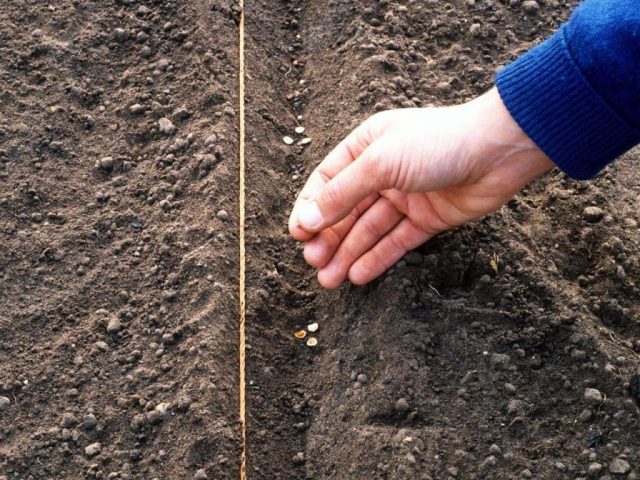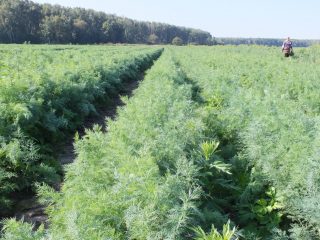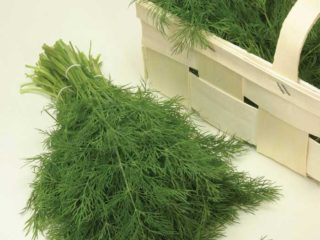Content
Dill Alligator began to gain popularity back in 2002, after the appearance of the variety as a result of the efforts of breeders of the Gavrish company - and to this day is in special demand among many gardeners. This is due to the fact that the harvest is carried out several times, because the crop throws out the umbrella only at the end of the season. The species belongs to bush crops with a raised large rosette, which makes it easier to care for the plant and does not become polluted during rain.
Description of dill alligator
The Alligator dill variety has the following distinctive features:
- the foliage of the bush is painted green with a bluish tint;
- the umbrella is thrown only towards the end of the season;
- raised socket - large;
- plant height can reach 160 cm;
- the crop harvested from one bush is, on average, 150 g.
Alligator dill is a late-ripening plant. The period of formation of foliage for greens is from 40 to 45 days, and you can harvest several times. The seeds are ready for harvest in 115 days.
The plant requires a lot of sunlight. Therefore, it is advisable to land in well-lit areas. Alligator dill, as shown by numerous reviews and photos, is successfully grown in many regions of Russia, in Ukraine and Moldova.
Characteristics of dill Alligator
Alligator bush dill is successfully grown even by novice gardeners. This process is not troublesome, it does not require the organization of additional conditions.
Dill yield Alligator
Collecting bush dill can begin in June and end only in September. Planting in open ground occurs both in late autumn and early spring, since the culture is cold-resistant and can withstand temperatures up to -8 degrees.
When grown for greens, can be harvested from 1 m2 up to 2.6 kg of dill. If seeds are collected, then from every 1 m2 get from 2.7 kg to 2.8 kg.
The yield of the Alligator variety mainly depends on the illumination of the plant with sunlight and the provision of favorable conditions, such as moisture and fertility of the soil and the introduction of the necessary additional amount of useful components into it.
Sustainability
According to the description, Alligator dill loves light and is also characterized as resistant to cold.
The variety does not differ in high immunity to diseases and pests, therefore, the use of preventive measures, such as seed dressing, will be required.
Advantages and disadvantages
The advantages of Alligator dill are evidenced not only by the description, but also by numerous consumer reviews. This crop can be grown both in the greenhouse and in the open field.
Positive characteristics of the variety:
- a large amount of harvest and multiple collection;
- slow stemming;
- the weight of one bush is 50 g;
- the density of greenery, which does not form baskets for a long period;
- juiciness of foliage.
Disadvantages of the variety:
- late maturation of seeds (mid-October), which, with an early onset of frost, leads to their darkening and deterioration;
- low germination.
Landing rules
You can plant Alligator dill seeds in open ground, starting in late autumn and ending in spring. In order to grow new planting material: it is advisable to plant the seeds in early spring, after the snow melts.
The Alligator variety can be planted for the winter. For this, the beginning of November is considered the best time. A few weeks before planting dill, it is necessary to prepare the soil by introducing the following components into it:
- compost or humus;
- potassium salt;
- superphosphate.
Then dig up the soil to a depth of 10 to 12 cm.
For planting the Alligator variety, it is also important to choose the right place, which should have the following characteristics:
- open, well-lit by the sun;
- proximity to low-growing crops: garlic, onions, cabbage;
- light loamy, sandy loam soil or chernozem with acidity not lower than pH 6.3 units.
For disembarkation, it is recommended to buy the original Alligator dill of the Gavrish company. It is worth paying attention to the preparation of planting material. To do this, soak is carried out, consisting of the following stages:
- The seeds of the plant should be rinsed well.
- Arrange in a container in a thin layer and pour a small amount of water at room temperature.
- After 20 minutes, add water at room temperature again, since the previous liquid is completely absorbed.
- Now it is necessary to change the water every 12 hours, stirring the planting material.
The seeds are soaked for 2 days, then they must be well dried.
How to prepare the site and plant the seeds:
- To process the soil surface in the area with a rake with frequent metal teeth.
- Use a pointed, convenient object to form rows 2.5 cm deep.
- The distance between the rows should be 20 cm.
- Water the finished furrows with water and send the planting material there, which then sprinkle with dry earth.
How the Alligator dill is planted is shown in the photo:
Growing dill alligator
The variety loves moisture very much, so regular watering is one of the most important nuances of growing.
In addition to watering, fertilizing plays an important role. It is especially worth paying attention to potash-phosphorus and nitrogen fertilizers. This will prevent yellowness on the dill branches. But too many of these components will not be beneficial, since the plant has the ability to absorb chemicals.
In the process of cultivation, it is necessary to regularly deal with the removal of weeds.
Collecting greens is simple: due to the large size of the bushes, you can safely cut off all the greens, leaving 2 - 3 branches for the further development of the plant. You can learn more about planting and growing Alligator dill from the video:
Diseases and pests
The most common diseases of Alligator dill include:
- Powdery mildew - appears when there is excessive air humidity or during a period of too cold air temperature in summer. It manifests itself as a powdery bloom on the branches of the plant. Over time, they begin to acquire a brownish tint and dry out. In order to prevent the onset of the disease, it is necessary to treat with a solution based on colloidal sulfur.
- Fomoz - This is an ailment characteristic of Alligator dill. May appear during periods of high humidity and high air temperatures. It manifests itself as brown spots on the leaf plates, which then lead to death. To prevent damage in the spring, it is necessary to treat the soil with special preparations - "Tiram" or "Fundazol".
- Blackleg - a common disease for many garden crops, in which rotting of the root necks occurs, over time passing to the stems, which leads to the complete drying out of the plant. Most often, damage occurs when dill is grown in greenhouses, where the air humidity is in excess. You can prevent the disease by constantly loosening the soil and treating it with Bordeaux liquid.
For Alligator dill, there are 2 types of pests: those affecting the root system and those living on the aerial part of the plant. The enemy of the root system is the bear, but for the aboveground part, the carrot beetle, the umbrella moth, and the blind are common.
To remove pests from green mass, spraying with Fitoverm solution is used. To eliminate the bear, the most common remedies are "Medvetoks", "Boverin".
Conclusion
Dill Alligator has long established itself as a high-yielding plant that does not require labor-intensive care and organization of special conditions. Therefore, many gardeners choose this particular variety.










